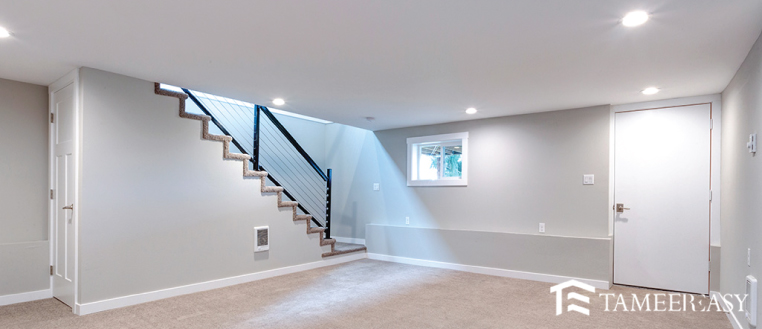Let’s discuss about basements. What is a basement, how is it constructed, what are its benefits and drawbacks, and what essential considerations should be considered before building it?
Visit TameerEasy Store to Purchase Quality Construction Items
This article will look at different aspects of the basement, providing you with the best information.

What is Basement?
A basement is a part of any building or structure typically constructed either entirely or partially below the ground floor of the building. It can consist of a single floor or a series of floors, which are built beneath the living or working spaces of the building. Basements can be found in various types of buildings, whether they are residential, commercial, or industrial.
Basements offer different types of benefits, depending on the nature of the building. In residential buildings, basements are often utilized for storage purposes, while in mechanical systems housing or for HVAC (heating, ventilation, and air conditioning) installations.
Advantages of Basement
- The most significant benefit is that it provides additional space within our area. In this same area, we gain an extra room that can be utilized in various ways.
- This space can be used as a family room, converted into storage space, turned into a home theater, designated as a play area for children, or even transformed into a guest room.
- Some individuals also create servant rooms here.
- Similarly, utility rooms can be established if there’s a need to incorporate HVAC-related components or mechanical fittings. These utility rooms can house electrical equipment or plumbing installations, and their placement ensures easy accessibility.
- Basements generally offer excellent storage space to store less frequently used items.
- Another significant benefit is the insulation it provides against noise and temperature fluctuations. It acts as a sound barrier, creating a conducive environment for activities like music practice and home theater enjoyment.
- Moreover, the basement’s temperature insulation ensures a distinct temperature difference from the ground floor.
- Additionally, basements come with a natural cooling system that enhances energy efficiency, reducing the reliance on excessive air conditioning. This natural cooling system often makes basements cooler than upper floors, offering energy-saving potential for air conditioning consumption.
- An essential advantage of basements is their potential to serve as storm shelters. Basements can offer a haven in areas prone to heavy rainfall or storms. During such adverse weather conditions, basements become a secure place to seek shelter, providing safety and protection.
In summary, basements offer a range of benefits. They serve various needs, from extra usable space to insulation advantages against noise and temperature fluctuations. Their role as storm shelters adds to their functionality, making them valuable to any property. If you’re considering building or utilizing a basement, remember its advantages and how it can enhance your living space.
Disadvantages of Basement
- The most significant disadvantage lies in its construction cost. Generally, a basement’s construction cost is higher than the ground floor or upper floors. This is because a particular type of foundation, waterproofing, and other elements entail substantial expenses.
- Another critical drawback is the potential for water issues. Basements often have a higher chance of leakage, especially if proper waterproofing or a well-designed drainage system is lacking. Poorly managed water systems can lead to dampness and mold issues. Consequently, this dampness can attract pests, including insects, rodents, and reptiles. If the basement isn’t properly sealed, the growth of these pests can become a problem.
- Likewise, a challenge with basements is the limited availability of natural light. Only a tiny portion of the walls allows sunlight to penetrate. However, adequate ventilation systems can be integrated with thoughtful design to enhance this aspect.
- Accessibility concerns also come into play. Creating proper in and out access requires technical expertise. Additionally, security concerns arise due to limited visibility in basements. This lack of visibility increases the potential for security risks.
Material Used in Basement Construction
In Pakistan, we use reinforced concrete work for basement construction. This type of concrete incorporates steel reinforcement, commonly used for its strength, versatility, durability, and customization capabilities. Similarly, concrete blocks can also be employed, or even concrete masonry units.
However, if we opt for concrete blocks, we must waterproof the external side properly. All joints must be sealed to prevent water entry, and this heavily depends on the external earth pressure we are dealing with and how to withstand it.
On the other hand, reinforced concrete efficiently manages these aspects, which contributes to constructing a basement. This method is called “cast in-situ” or “poured concrete.
Process of Constructing Basement
The first step is determining where we plan to construct the basement. For instance, assessing the location and following the designer’s or architect’s feasibility is essential if it’s beneath a double-story house.
The next crucial aspect is understanding the scope, including excavation for basement construction, the type of foundation work, structural elements, and necessary waterproofing measures.
Health and safety considerations are paramount during excavation, ensuring that hazards are minimized, neighboring buildings are secured, and the environment remains unaffected.
Workers involved wear Personal Protective Equipment (PPE) to prevent accidents. Site preparation follows, ensuring the secure area where the basement will be constructed. Safety barriers are set up, and utilities are rerouted if needed, focusing on safe practices.
The excavation’s scale depends on the basement size, and it’s often done with an excavator. Excavated material is either dumped on-site or disposed of elsewhere.
Foundation work comes next, addressing issues such as termite treatment, steel fixing, lean concrete, and waterproofing. Structural elements like walls and columns, if present, are designed accordingly.
After basement construction, walls and upper slabs are added, acting as the ground floor. Curing time is allowed before applying waterproofing, which can vary in types like Cementitious Waterproofing, liquid waterproofing membrane, bituminous coating, bituminous membrane waterproofing, polyurethane liquid waterproofing, etc., based on cost considerations.
The gap between excavation lines and walls is filled, followed by compacting. An effective disposal system is developed for water-related structures, often referring to public health guidelines. Special attention is given to creating emergency exits for safe evacuation during unforeseen incidents.
Conclusion
We hope you now understand what a basement is, how it is constructed, its advantages and disadvantages, and the preventive measures needed. If you need further guidance on this topic or have any questions, please visit our website “tameereasy“ for more information.







